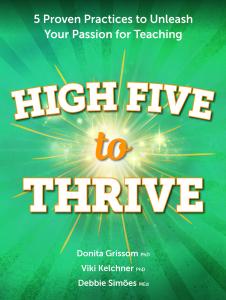'High Five to Thrive' Empowers Teachers to Thrive One High Five at a Time and Stay Connected to Their Purpose
In their new book, “High Five to Thrive,” veteran educators provide a guide to empower teachers to reignite their passion for their work.
A recent Gallup Panel Workplace Study found that 44% of K–12 educators say that they are “always” or “very often” feeling burned out at work, making them the group of workers with the highest burnout rate. In the aftermath of the Covid 19 pandemic, teacher retention became a hot topic because of the unexpected shifts in teaching modes, the pressures to quickly adapt to new technologies, and the challenges in managing their own health concerns. At the same time, the teacher shortage adds to the stress and workloads of teachers currently in the classroom. Grissom, Kelchner, and Simões were motivated to write “High Five to Thrive” to prevent and alleviate teacher burnout, increase teacher retention and ultimately student success with actionable strategies.
“We want ‘High Five to Thrive’ to be a resource to help teachers reaffirm their sense of purpose and service, which brought them to the profession while supporting their whole selves. This will equip them to create a classroom culture where everyone flourishes! At the same time, we want to make sure that professional fatigue does not impact teachers’ praxis and their mental and physical health,” Grissom said. “Our goal is to help foster resilience in teachers so they bring their best versions of themselves into the classroom and are effective instructors for their students.”
“The tools and assessments that we provide in ‘High Five to Thrive’ come out of our work as educational researchers and practitioners. We’re integrating what we have learned in the field to create a roadmap for the greatest impact in and outside of the school environment. We are losing good teachers, the foundation of every walk of life, the world’s future–we must work together to find ways to support educators, while developing lifelong learners,“ said Kelchner.
“Over the past three decades, I have been in countless classrooms and teacher professional development sessions across the country, where my goal has been to provide effective strategies that teachers can implement immediately to improve teaching and learning. ‘High Five to Thrive’ helps teachers take stock of their purpose and value, which is important in these uncertain times in our profession,” said Simões.
Donita Grissom, Ph.D. is a Senior Lecturer at the University of Central Florida and has a background in teacher education specializing in teaching English as a Second Language. Also, she is a Hope Science Specialist and Life Coach helping educators and leaders across the country strengthen goal-setting, critical thinking, and strategic planning skills. Her work focuses on rewiring thinking patterns to foster resilience, motivation, and sustainable success.
Viki Kelchner, Ph.D. is a Counselor Educator, a licensed professional counselor, and a certified school counselor. She has over 25 years of working experience in K–12 schools. Her expertise is in school based interventions for families and trauma informed practices.
Debbie Simões, M.Ed., is an experienced educator who has served as a teacher, principal, and director at a university lab school. As a professional education consultant and founder of Best Questers, she leads dynamic professional learning retreats and leadership development experiences for educators. Debbie brings deep expertise in school culture, instructional leadership, and educator well-being. She is passionate about helping people connect, feel seen, and recognize their value.
To learn more about “High Five to Thrive,” click here https://bestquesters.com/.
“High Five to Thrive" is the fifth title by Soro Publishing, a hybrid publishing company based in Southern California.
ABOUT SORO PUBLISHING
Soro Publishing is the most author-focused publishing solution. Soro Publishing is proud to commit to the Independent Book Publishers Association Hybrid Publisher Criteria. To learn more about Soro Publishing, visit soropublishing.com.
Adriana Maestas
A Call To Action, Inc.
info@acalltoaction.consulting
Legal Disclaimer:
EIN Presswire provides this news content "as is" without warranty of any kind. We do not accept any responsibility or liability for the accuracy, content, images, videos, licenses, completeness, legality, or reliability of the information contained in this article. If you have any complaints or copyright issues related to this article, kindly contact the author above.
Flour Treatment Agents Market is Estimated to Reach USD 1,407 Million by 2035 | Fact.MR
Coffee Concentrates Market Registering at a CAGR of 5.0% from 2023 to 2032 and to reach $3.6 billion by 2032
Post-Op Shoe Market is likely to expand US$ 1.1 billion at 5.1% CAGR by 2031
Kalendarium
Więcej ważnych informacji
 Jedynka Newserii
Jedynka Newserii

 Jedynka Newserii
Jedynka Newserii

Finanse

Europosłowie za wydłużeniem finansowania krajowych planów odbudowy o 1,5 roku. Apelują o większą przejrzystość wydatków
Instrument na rzecz Odbudowy i Zwiększania Odporności (RRF) – uruchomiony po pandemii COVID-19 – wygasa w sierpniu 2026 roku. Europosłowie w przyjętej niedawno rezolucji postulują, by przedłużyć ten termin o 18 miesięcy dla kluczowych projektów bliskich ukończenia. To szczególnie ważne dla Polski, która przez trzy lata – przez spór poprzedniego rządu z Komisją Europejską – miała zablokowany dostęp do środków z Krajowego Planu Odbudowy (KPO). Jednocześnie rezolucja wzywa do większej przejrzystości wydawanych funduszy.
Polityka
Prof. G. Kołodko: Druga prezydentura Trumpa zmienia Amerykę i świat na gorsze. Nie przyczynia się do rozwiązywania fundamentalnych światowych problemów

Zdaniem byłego wicepremiera i ministra finansów, prof. Grzegorz Kołodki, trumpizm wzmacnia pewne trendy nacjonalizmu, populizmu ekonomicznego i handlowego nie tylko w Ameryce, ale także w innych państwach. W ocenie ekonomisty Trump i trumpizm będą mieli negatywne skutki dla światowych procesów demograficznych, społecznych, kulturowych i ekonomicznych. Prezydentura Trumpa nie skupia się na rozwiązywaniu najważniejszych światowych problemów, takich jak m.in. migracja, zimna wojna, czy też ocieplenie klimatu.
Konsument
Branża opakowań nie traktuje unijnych regulacji jako zagrożenia. Widzi w nich impuls do rozwoju

W UE co roku wytwarza się ponad 2,2 mld t odpadów. Aby ograniczyć ich ilość, promowane jest przechodzenie na bardziej zrównoważony model, czyli gospodarkę o obiegu zamkniętym. W ramach pakietu zmian prawnych ograniczających negatywny wpływ działalności człowieka na środowisko nacisk położony jest w dużej mierze na producentów opakowań. Przedstawiciele branży podkreślają, że nowe regulacje to dla nich nie tylko nowe obowiązki, ale też okazja na zbudowanie przewagi konkurencyjnej.
Partner serwisu
Szkolenia

Akademia Newserii
Akademia Newserii to projekt, w ramach którego najlepsi polscy dziennikarze biznesowi, giełdowi oraz lifestylowi, a także szkoleniowcy z wieloletnim doświadczeniem dzielą się swoją wiedzą nt. pracy z mediami.









.gif)

 |
| |
| |
|